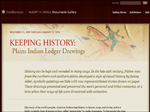As COVID-19 deaths spiked in 2020, Suzanne Firstenberg’s public art installation "In America: How could this happen…"
History Explorer Results (31)
Related Books (10)

Grade Range:
K-12
Resource Type(s):
Artifacts
Date Posted:
4/7/2016
The National Cash Register Company produced this Model 421 cash register around 1914. The register was used in a Marshall Field & Company department store. The register has three columns of keys for entering numbers, and a fourth column of function keys. The operating crank is on the right si

Grade Range:
5-12
Resource Type(s):
Reference Materials
Date Posted:
9/4/2013
Between the years 1790 and 1880 the U.S. Patent Office required both documentation and a three-dimensional working model to demonstrate each new invention submitted for a patent. The models helped to explain proposed innovations and compare them against similar inventions. In this online exhibiti

Grade Range:
6-8
Resource Type(s):
Interactives & Media, Worksheets
Duration:
11 minutes
Date Posted:
11/20/2012
In this episode of the History Explorer Podcast, curator Rayna Green discusses what we can learn from seemingly simple line drawings about the lives and memories of Plains Indians who lived over 130 years ago. The resources include a teacher guide and related image.

Grade Range:
K-12
Resource Type(s):
Reviewed Websites
Date Posted:
7/19/2012
In this activity, students will enlist and experience the life of a young sailor aboard USS CONSTITUTION during the War of 1812. Students will scrub the deck, haul on lines, steer the ship, work the guns, tell tall tales, and perhaps sneak a gam

Grade Range:
K-12
Resource Type(s):
Reviewed Websites
Date Posted:
3/9/2012
Search over 7.4 million records with 568,100 images, video and sound files, electronic journals and other resources from the Smithsonian's museums, archives & libraries.

Grade Range:
5-12
Resource Type(s):
Artifacts, Primary Sources
Date Posted:
12/28/2010
Built by contract with John Ericsson at Green Point, Long Island, and launched January 30, 1862, the USS Monitor saw its first naval action at Hampton Roads, Virginia, on March 9, 1862. Despite the CSS Virginia being almost twice its size, with ten guns, the Monitor wit

Grade Range:
K-12
Resource Type(s):
Artifacts, Primary Sources
Date Posted:
11/10/2010
Cherished by generations of child artists, Crayola crayons were invented in 1903 by the Binney & Smith Company of Easton, Pennsylvania. Using paraffin wax and nontoxic pigments, the company produced a coloring stick that was safe, sturdy, and affordable. The name "Crayola," coined by the wife

Grade Range:
9-12
Resource Type(s):
Reference Materials, Primary Sources
Date Posted:
6/3/2010
Tell the story of early American science with an online exhibition and digital reproduction of the oldest surviving Anglo-American star map. This hand-drawn star map, created in 1780, reflects a story of scientific curiosity and the practical applications of astronomy in colonial America. Simeon

Grade Range:
2-12
Resource Type(s):
Reference Materials, Primary Sources
Date Posted:
11/30/2009
The drawings included in this online exhibition are first-person records of military conflicts, cultural life, and "Americanization." The website shares an American Indian perspective on westward expansion through primary sources. In the late 19th century, life was changing rapidly for the N

Grade Range:
5-12
Resource Type(s):
Reference Materials
Date Posted:
10/31/2009
Students will learn about American industrial creativity by looking at industrial drawings, considering their aesthetic value as well as their importance to the design process. Engineers, inventors, and designers produce drawings as part of their creative process. They draw to work


















